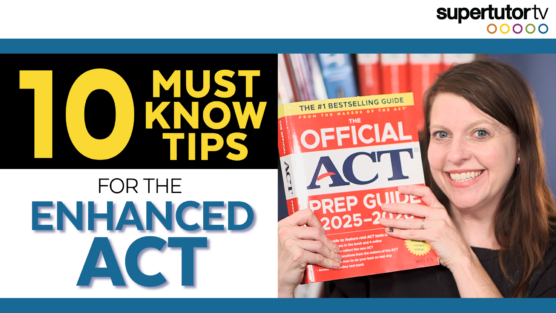Looking for tips and tricks to improve your SAT® essay score? Unfamiliar with the new SAT® essay and want to do better? Below I go over a few SAT® writing tips to help you write a stronger SAT® essay and improve your score.
If you have no idea what the SAT® essay is about, you can first check out our video that compares the SAT® essay to the ACT® essay and you can download a copy of an actual SAT® practice essay.
In the video above, I use the prompt from SAT® 2015 Practice Test #3 Essay as an example– I recommend you download that prompt, read through it and familiarize yourself with the task of the essay and then come back here for tips.
If you’d like to see the full EXAMPLE ESSAY that I wrote based on my work in this video (and that you see on screen and I discuss), check out this blog post: SAT® Essay Example: How to Get a Perfect Scoring Essay
Part 1: The Intro Paragraph
TIP 1. Focus on Technique: Find 3 types of techniques used in the passage and put them in your thesis.
To improve your score, you don’t want to just summarize the passage or just analyze 3 techniques that the author is using; you want to do both! But what most students neglect is clearly finding three techniques the author employs to better persuade her or his readers.
How do you craft an introduction to make sure you get all the points possible in the essay? Always try to find a good point of analysis that you are able to dig deeper into! Don’t create a thesis based only on a superficial observation. Find an analysis point that you can turn into a deeper discussion and analysis.
Remember, you’ll need to explain not only how these techniques are employed, but also the point the author is making with them. You pick up reading points from showing that you understand what the author is saying in the essay, and you pick up analysis points by showing the strategies the author employs to get that point across. The trick is to connect how these techniques have an effect on the reader and what they have to do with the main idea the author is trying to establish.
Part 2: The Body Paragraphs
TIP 2. Analyze the essay using these 4 steps in your body paragraphs:
Step 1: Identify the technique and purpose. (This is one of the three pieces of your thesis– each one can be part of a transition sentence that opens the body paragraph).
Step 2: Cite the technique. Use paraphrasing and direct quotes to show how the author employs the technique you’ve identified. Be sure to set up your quote or paraphrase so that it seamlessly flows and the point the author is making with that quote is also clear.
Step 3: Explain how the technique contributes to the author’s message and meaning. In other words, explain how the quote reveals the argument and how the technique strengthens that argument.
Step 4: Show what the end game effect of the technique is on the reader.
Part 3: The Writing
3. Perfect your Writing Prowess
Become a better writer through bettering your style. Check out some of these books to help you improve your writing style!
Here are some books I recommend (links to Amazon):
The Elements Of Style by Strunk & White
This is a total classic– it’s the authority on how to write concise, effective sentences. It’s available at almost any library and free on the Kindle.
Writing Tools by Roy Peter Clark
This is a reference style guide that goes through how to create certain effects by using particular writing and rhetorical strategies.
They Say, I Say by Gerald Graff and Cathy Birkenstein
This text is helpful both from an analysis point of view (i.e. it will help you analyze essays from SAT® prompts) and a writing one (i.e. it will help you become a better writer of essays– with more tools in your tool box). The tools it discusses are more specific than the other two books, so may not work in every situation, but are still foundational elements to good academic writing.
Good luck in writing those essays! Stay connected with us by subscribing to our YouTube channel, mailing list, and make sure to follow us on social media for more tips on how to improve your SAT® score.
(Disclaimer: this post may include Amazon affiliate links. Your purchase through these links helps support our site! We have not been paid in any way by any of the authors or publishers of these books to recommend them).




